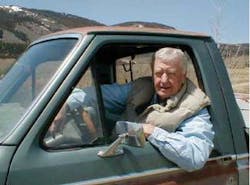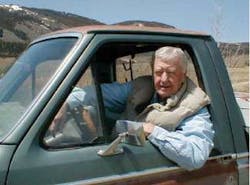Letters
Founder looks back as Coherent marks 40 years in business
As Coherent celebrates its 40th anniversary this year, I’m prompted, as one of its founders, to recall some of the events that led to the company’s birth. The genesis of Coherent Radiation Laboratories (now Coherent) can be traced to 1965, when Spectra-Physics declined to develop gas ion lasers. Prior to the 1964 discovery of the mercury-vapor ion laser by Spectra-Physics scientist Earl Bell, the conventional wisdom among the laser scientific community was that ions would not remain in the excited state sufficiently long to maintain laser action. Bell’s revolutionary discovery led to a variety of noble-gas ion lasers, especially argon and krypton. As manager of sales and marketing at Spectra-Physics, I was aware of the growing demand among the laser research community for continuous-wave (CW) lasers and was frustrated that the company wasn’t willing to capitalize on the exploding interest in CW gas ion lasers.
The American Physical Society Meeting and Exhibit in New York proved to be the precipitating event in the formation of Coherent Radiation Laboratories (CRL). The discovery in 1964 of the CO2 gas laser by Kumar Patel at Bell Labs was important because it was the first laser capable of doing useful work. At the exhibit, I was impressed with the simplicity of Perkin-Elmer’s CO2 laser. Soon after, I proposed to the Spectra-Physics board of directors that the company immediately begin development of a line of CO2 lasers. The board rejected my proposal, and I promptly announced my resignation from the company and my intention to start a new venture to produce noble-gas ion and CO2 lasers.
Acting on the vision
I asked my best friend, Earl Bell, to be cofounder of the new enterprise and, at first, he signed on. He was truly an intuitive scientific genius and I believed it was crucial that he be the technical leader of the new company. During this time, I was looking for investors and approached the DuPont Company-it was funding new technologies and had a strong interest in holography.
At DuPont New Technologies, Ed Gee, and his assistant, Dan Friel, explained their interest in multiwavelength “white light’ lasers for their holography project and asked if my new company would be able to provide this capability. Not knowing otherwise, and with Earl Bell as my technical guru, I said, “Yes, we can do that.” It was agreed that I would form and staff my new company and then return to negotiate the terms of a deal that might result in the DuPont Company being the company’s initial outside investor.
Coherent Radiation Laboratories is formed
Upon returning home, I received my first and most serious setback. Earl Bell had decided that, as a founder of Spectra-Physics, he could not abandon his fellow founders to what some viewed as a potentially competing enterprise, even though Spectra-Physics was not producing either gas ion or CO2 lasers.1 Earl was gone.2 However, Jim Hobart, an extraordinarily skillful laser scientist at Spectra-Physics, was attracted to the start-up opportunity and agreed to sign on. His close associate at Spectra-Physics, Wayne Mefferd, also signed on, and proved to be the consummate mechanical engineer. Steven Jarrett, who had been at the University of Michigan with Hobart, agreed to join the venture. Finally, Bob Rorden, an electronics engineer at Varian Associates Instrument Division, agreed to leave Varian to round out our technical team.
To finance the startup, we used $20,000 from the sale of some Varian stock I had acquired during my tenure there-$175,000 in today’s dollars. We moved the enterprise into my house in Palo Alto, CA, and set up a laser development lab in my laundry room, which had running water and 220 V AC. I then left for the East Coast to negotiate a deal with DuPont.
Enter DuPont
A deal was soon sealed with DuPont. DuPont would give CRL a contract to develop a 100 W CO2 laser product within nine months, and we were to make at least one delivery to a legitimate customer. During that period, DuPont would pay for all expenses, including salaries. In return, DuPont would receive an option to take a minority position in the company, to be exercised at the end of the nine month period. When we shook hands, Ed Gee offered what was to be an ominous caveat. He said, “Gene, you have to keep uppermost in your mind that DuPont, for whatever reason, may not exercise the option to invest at the end of the nine month period. By that time you will have acquired spending momentum and you need to plan for that possibility.” I took this as a routine comment, believing that we would perform and so would DuPont.
The nine months went by in a blur and included a demonstration that the laundry-room CO2 laser was real by reflecting the beam onto my neighbor’s garage door. The growing, darkening, smoking spot proved that the beam was coherent. My neighbor, not a nice guy, deserved it-and never learned what that mysterious spot was. We retained an industrial-design firm, GVO, to give our new laser an award-winning appearance (it won the 1966 WESCON design award). Then, Jim Hobart and I made a memorable delivery to our first customer, the Boeing Manufacturing Research Lab in Seattle. I say memorable because we first became aware that the laser was operating properly when we discovered that we were burning a hole in our customer’s new birthday present from his wife, a tweed jacket. We were excited that our first delivery was successful-he was not impressed, at least not until we took him to the store and replaced his jacket.
Now, the real excitement began. The nine months were up and I was in the DuPont headquarters in Wilmington, DE, to seal the deal on the exercise of its option. There was some urgency on my part-as Ed Gee had forewarned, we now had significant spending momentum. Ed began the conversation by reminding me of his earlier caution and then he said that the DuPont Company was not going to exercise its option. Ed explained that, for the first time, this 100+-year-old company was facing a cash-flow shortfall. He knew all outside investments were on hold and our deal would not get a hearing in this crisis environment-in short, end of deal.
Exit DuPont; enter the Rockefellers
Stunned, I asked Ed if I could sit in his conference room for a while to collect my thoughts. Spending momentum was uppermost on my mind. I was already on the East Coast so I thought I might as well talk to East Coast people. Then I thought of the Rockefellers-but I knew the Rockefellers wouldn’t be interested in any deal DuPont had turned down, so I needed Ed Gee’s help. I went back to his office and told him my plan. He was not enthusiastic about telling anyone about the impending DuPont cash crunch, but he agreed to tell one person, on the phone, one time. “Be sure I’m talking to the right person,” he said.
I went to Gee’s outer office, got the Manhattan phone book and found “Rockefeller Family & Associates-30 Rockefeller Center.” I called the number and told the receptionist, “I have a laser company in which the DuPont Company has an equity option. DuPont is quite pleased with the progress of my company but, for internal reasons not publicly known, they are unable to exercise their option at this time. My question is, ‘Is your organization interested in picking up the DuPont option?’ ” The receptionist asked me to hold, and after some time, another voice came on the line and said, “This is Charles Smith-what is it that you want to talk about?” I told him our story, and that the DuPont folks were willing to corroborate the facts-but to only one person, on the phone, once. I told Mr. Smith that I really needed to know if he was the right person. After a pause, he said, “Yes, Gene, I am the right person.” I put Ed Gee on the phone and, true to his word, he told the complete story, adding that were it not for their cash flow issue, he was certain DuPont would have exercised their CRL option.
I flew to New York and soon I was entering the hushed, richly paneled inner sanctum of Rockefeller Family & Associates (now Venrock Associates). Many subsequent discussions with Smith culminated in the Rockefeller family members becoming minority shareholders in CRL. And I mean family-I received an envelope in the mail containing personal checks signed by the brothers David, Laurence, Nelson, and sister Abby.
Sometime later, Smith said, “. . . you know Gene, you had no chance of getting a hearing at our group-we get over 1000 proposals a year-except I just had to know what was going on at DuPont.”
The rest is history
Today, with annual sales approaching $600 million, Coherent has 2200 employees and operations spanning the globe.
Eugene (Gene) Watson
Founding CEO of Coherent
[email protected]
1. Soon after the formation of CRL, Spectra-Physics began the development of ion and CO2 lasers.
2. Eight years later, Earl Bell and I became cofounders of Quanta-Ray, which was subsequently sold to Spectra-Physics.
Editors note: An extended version of this letter is available at www.laserfocusworld.com/articles/259946.
Caltech group has demonstrated efficient single-photon emission
We are writing in regard to the article “Its Hard to Get Just One Photon” by Jeff Hecht (June 2006, p. 69; www.laserfocusworld.com/articles/257230). First, thank you for featuring this important field of research in your magazine. Great strides have been made in the past few years toward achieving a true single-photon source and toward the realization of quantum-information protocols that such a source would enable.
We must point out a serious error present in the article, however, regarding the advances made using trapped atoms coupled to high-finesse optical resonators as sources of single photons. The author makes reference to the work conducted in H. Jeff Kimble’s group at Caltech, citing our demonstration in 2003 of a single-atom laser, but concludes that our “group’s single-atom lasers do not emit single photons.” Much to the contrary, in 2004 our group used this system with pulsed excitation as an efficient means for generation of single photons on demand (J. McKeever et al., Science 303, 1992 [2004]). In this paper we show that our single-photon source operates at 100 kHz repetition rate with near unit efficiency for the transfer from atom to field and with very little contamination from two-photon events-characteristics that make it an extremely competitive alternative to the other types of sources cited in the article.
Although it is excellent that research into single-photon sources is receiving attention from your magazine’s broad readership, we feel it is crucial that this important contribution to the field not be overlooked.
Russell L. Miller, Graduate Stu
H. J. Kimble, Professor
Andreea Boca, Research Scientist
David Boozer, Research Scientist
California Institute of Technology
Quantum Optics Group
1200 E. California Blvd. MC 12-33
Pasadena, CA 91125
[email protected]
Editors note: In his research for the June Photonic Frontiers article, Jeff Hecht unfortunately missed the 2004 paper published by the CalTech group. Laser Focus World regrets the error.
CORRECTIONS
The photo of the three-dimensional
image cube that appeared on the cover and on p. 63 of the July issue was incorrectly credited. The image was from the Rochester Institute of Technology.
In “Picosecond fiber laser targets pulsed laser deposition” (July, p. 40) the energy of the laser pulse was given as mJ when it should have been µJ.
Laser Focus World regrets the errors.
We welcome your comments. Send letters to Carol Settino, Managing editor, at [email protected].
Letters may be edited for length.

